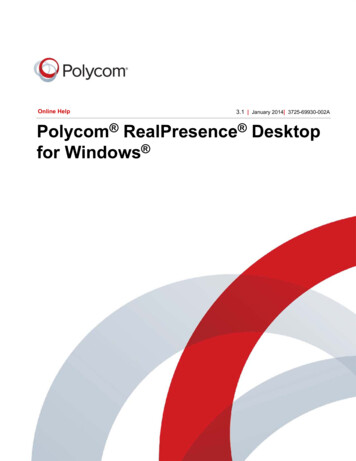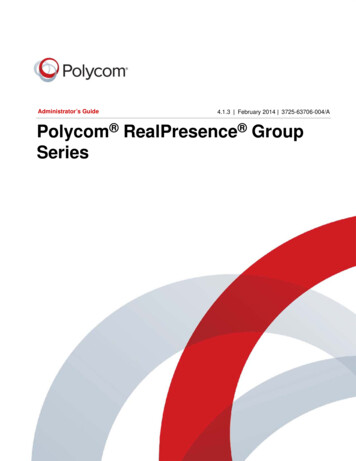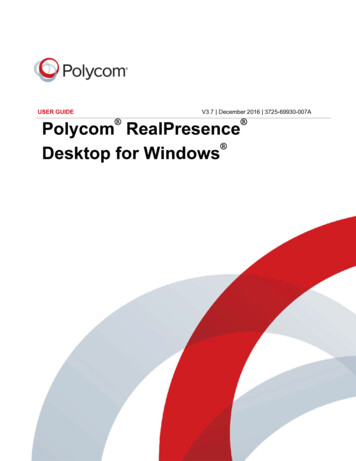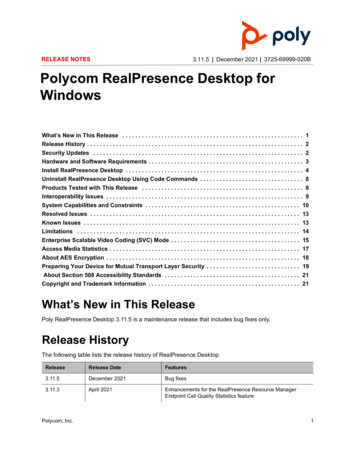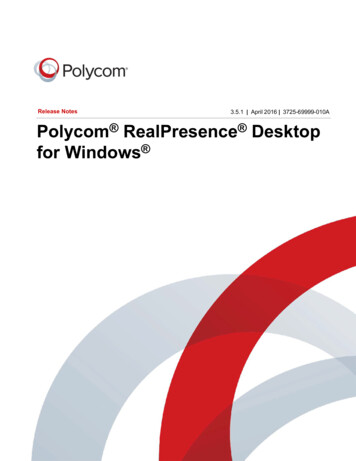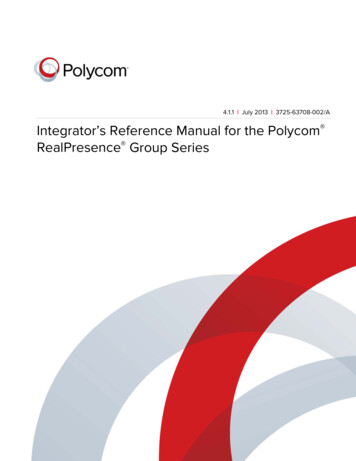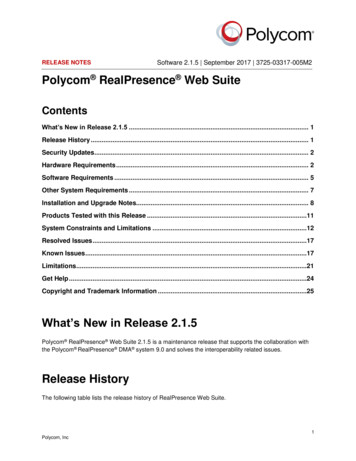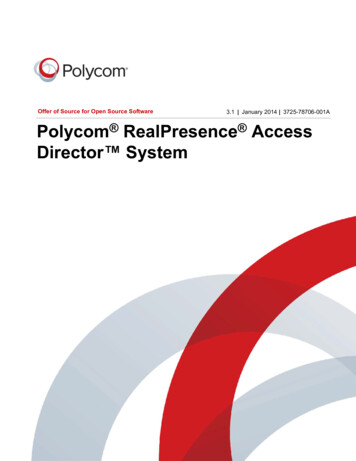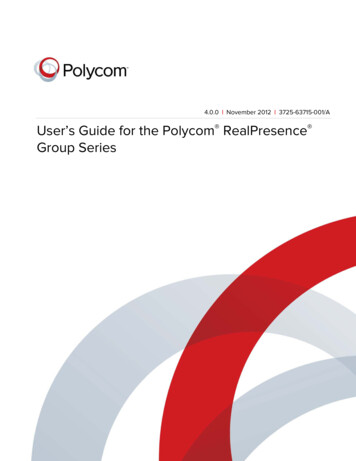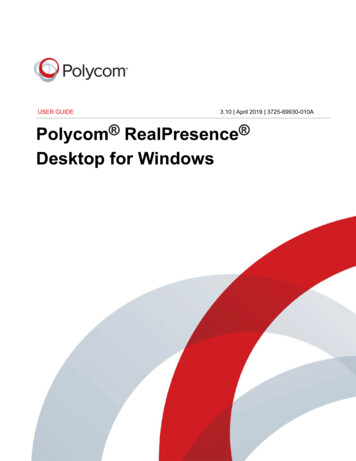
Transcription
USER GUIDE3.10 April 2019 3725-69930-010APolycom RealPresence Desktop for Windows
Copyright 2019, Polycom, Inc. All rights reserved. No part of this document may be reproduced,translated into another language or format, or transmitted in any form or by any means, electronic ormechanical, for any purpose, without the express written permission of Polycom, Inc.6001 America Center DriveSan Jose, CA 95002USATrademarks Polycom , the Polycom logo and the names and marks associated with Polycom productsare trademarks and/or service marks of Polycom, Inc. and are registered and/or common law marks in theUnited States and various other countries.All other trademarks are property of their respective owners. No portion hereof may be reproduced ortransmitted in any form or by any means, for any purpose other than the recipient's personal use, withoutthe express written permission of Polycom.End User License Agreement By installing, copying, or otherwise using this product, you acknowledgethat you have read, understand and agree to be bound by the terms and conditions of the End UserLicense Agreement for this product. The EULA for this product is available on the Polycom Support pagefor the product.Patent Information The accompanying product may be protected by one or more U.S. and foreignpatents and/or pending patent applications held by Polycom, Inc.Open Source Software Used in this Product This product may contain open source software. You mayreceive the open source software from Polycom up to three (3) years after the distribution date of theapplicable product or software at a charge not greater than the cost to Polycom of shipping or distributingthe software to you. To receive software information, as well as the open source software code used inthis product, contact Polycom by email at OpenSourceVideo@polycom.com (for video products) orOpenSourceVoice@polycom.com (for voice products).Disclaimer While Polycom uses reasonable efforts to include accurate and up-to-date information in thisdocument, Polycom makes no warranties or representations as to its accuracy. Polycom assumes noliability or responsibility for any typographical or other errors or omissions in the content of this document.Limitation of Liability Polycom and/or its respective suppliers make no representations about thesuitability of the information contained in this document for any purpose. Information is provided "as is"without warranty of any kind and is subject to change without notice. The entire risk arising out of its useremains with the recipient. In no event shall Polycom and/or its respective suppliers be liable for anydirect, consequential, incidental, special, punitive or other damages whatsoever (including withoutlimitation, damages for loss of business profits, business interruption, or loss of business information),even if Polycom has been advised of the possibility of such damages.Customer Feedback We are striving to improve our documentation quality and we appreciate yourfeedback. Email your opinions and comments to DocumentationFeedback@polycom.com.Polycom Support Visit the Polycom Support Center for End User License Agreements, softwaredownloads, product documents, product licenses, troubleshooting tips, service requests, and more.
Contents Polycom RealPresence Desktop Modes of Operation.4Getting Started with RealPresence Desktop. 5Get Started with RealPresence Desktop in Standalone Mode.5Get Started with RealPresence Desktop in Managed Mode.5Sign Out from the Provisioning Server.6Check Your Connection Status. 6Connection Status Information.6Startup Options. 8Remember My Startup Choice.8Set Your Startup Preference. 8Configuring Application Settings. 9Enable or Disable SDP Size Adjustment. 9Configure Profile Information. 10Configure Profile Photo. 10Virtual Business Card.10Set Virtual Business Card.11Start RealPresence Desktop Automatically When Your System Powers up. 11Answer Incoming Calls Automatically.11Open Links Using RealPresence Desktop. 11Configure Call Rate.12Configure Call QoS. 12Configure H.323 Settings (Standalone Mode Only). 13Configure SIP Settings (Standalone Mode Only).13Configure Audio Devices.14Enhancing My Audio Experience. 14 Enable Polycom Acoustic Fence for USB Headsets. 14 Enable Polycom NoiseBlock . 14Enable Mute Reminder. 15Configure Camera.15Configuring Network Settings.15Configure Video Ports. 15Configure NAT.16Set Closed Captioning. 16Polycom, Inc.1
ContentsEnable Automatic Face Brightness Adjustment. 16Set My Default Call Type.17Display Test Features.17Call Management.18Access Calling Features. 18Call by Entering a Number. 18Call from the Corporate Directory. 19Call from Local Address Book.19Answer a Call. 19Reject an Incoming Call. 19End a Call.20Calling a SIP User Directly.20Controlling Meeting Using the In-call Toolbar.20View Network Call Statistics. 20Show or Hide Local Self-View. 20Maximize or Restore Application Window. 20Pause or Start Your Video. 20Mute or Unmute Your Microphone.21Adjust Your Speaker Volume.21Far End Camera Control. 21Select Audio and Video Preferences During a Meeting. 22Hide or Show More In-call Controls.22Call Icons. 22View Recent Calls. 22Change the Video Layout.23Managing Contacts. 24Access Contacts. 24Add a Contact to Your Local Address Book Manually.24Add Contacts from the Corporate Directory to Your Local Address Book.25Edit a Contact in Your Local Address Book.25Search for a Contact. 26Delete a Contact. 26View Organization Hierarchy.26Importing and Exporting User Profile. 26Export User Profile. 26Import User Profile. 27Sharing Content. 28Polycom, Inc.2
ContentsShare Content. 28Maximize and Restore Your View. 28Stop Content Sharing.28 Using Polycom SmartPairing . 29Share Your Monitor or Application with the Paired System.29Use Your Device as the Paired System’s Remote Controller.29Chat and Presence. 31Presence Statuses. 31Change My Presence Status.31Chat with a Contact.32Chat with Meeting Attendees During Video Call. 32 Polycom MusicMode . 33Enable Music Mode.33Disable Music Mode.33Calibrate Noise Floor. 34Disable Acoustic Echo Canceler. 34Troubleshooting. 35Send Application Log Files.35Access the User Guide. 35I Cannot Find the Content Button.35I See an Exclamation Mark on the Microphone Icon.36Prevent RealPresence Desktop to Take Exclusive Control of the Microphone.36H.323 Registration Problems. 36Encryption Information.37Polycom, Inc.3
Polycom RealPresence DesktopModes of OperationRealPresence Desktop has two modes of operation: In standalone mode, supports registration and calling with an H.323 gatekeeper and/or a SIPserver. It does not require registration with a Polycom provisioning server such as a Polycom RealPresence Resource Manager system. In standalone mode, you have direct access to theconfiguration and settings of .You must purchase a license and enter licensing information manually to use this beyond the 30day trial period. In managed mode, registers with a Polycom provisioning server like a RealPresence ResourceManager system. The Polycom provisioning server configures automatically. It also provides accessto a centralized directory server. In managed mode, the Polycom provisioning server manageslicensing of , so you do not need to purchase an individual license.Polycom, Inc.4
Getting Started with RealPresenceDesktopTopics: Get Started with RealPresence Desktop in Standalone Mode Get Started with RealPresence Desktop in Managed Mode Sign Out from the Provisioning Server Check Your Connection Status Connection Status InformationWhen first signing into RealPresence Desktop application, you have the following options based on themode of operation: Select Individual when using RealPresence Desktop in standalone mode. Select Enterprise when using RealPresence Desktop in managed mode.Get Started with RealPresence Desktop in StandaloneModeStandalone mode does not require registration with a Polycom provisioning server. You need to configureRealPresence Desktop manually.1. Start RealPresence Desktop and select Individual on the Login page. Then select Enter.2. Do one of the following: Select Trial to use the RealPresence Desktop application as a trial. Select Activate to activate the application with a license. Then import your license, or enteryour license and activation key.Get Started with RealPresence Desktop in ManagedModeIn managed mode, will try to discover the provisioning server from which it will receive its license and getsome configuration settings. You use your company account to log into . LDAP search feature is onlysupported under the managed mode.1. Start RealPresence Desktop and select Enterprise on the Login page. Then select Enter.2. Do one of the following: Polycom, Inc.To let the application find your provisioning server based on your email address, enter youremail address (usually your corporate email address), and then select Next.5
Getting Started with RealPresence DesktopNote: If no server name appears in the Server field, the application cannot find aprovisioning server. Contact your IT administrator for the information to enter into theServer field. To specify a provisioning server, leave the email address blank, and then select Next. Thenenter your server address in Server: text field and select Next.3. Enter your User Name and passcode.If you select the Sign in using network login credentials check box, RealPresence Desktop willuse your Windows login credentials to sign in.4. Select Sign In. RealPresence Desktop will discover the provisioning server automaticallyNote: When Extensible Messaging and Presence Protocol (XMPP) service stops working, if yousign into more than one RealPresence Desktop, the later RealPresence Desktop will fail toregister H.323 because of a duplicate alias error.Sign Out from the Provisioning ServerYou can sign out from the provisioning server and choose to work in other operation modes.» Selectand then select Sign Out.Check Your Connection StatusYou can check your connection status such as your meeting number and server address by clicking ortapping.» Selectto see connection status information.If the gatekeeper or server registration fails,more information.is displayed on the main window. Selectto seeConnection Status InformationThe following connection information may be available.FieldsDescriptionMy NumberNumbers the far end can use to call you. Depending on your dialing plan, the farend may call you with any of your numbers, including your IP address. Ask yourIT administrator for more information.ProvisioningProvisioning server address.H.323H.323 gatekeeper.SIPSIP configuration information.Polycom, Inc.6
Getting Started with RealPresence DesktopFieldsDescriptionNetworkIP address the far end can use to call you.XMPPIP address of the Extensible Messaging and Presence Protocol (XMPP) server.Polycom, Inc.7
Startup OptionsTopics: Remember My Startup Choice Set Your Startup PreferenceBy default, the RealPresence Desktop starts up on its home page, showing the following two options: Place a CallMake calls or access contacts. Connect to RoomConnect to a room to share content.You can let the RealPresence Desktop remember your startup option. You can also change the settingslater.Remember My Startup ChoiceThe first time you start up the RealPresence Desktop, you can let the application to remember yourchoice on the home page and bring you directly to the relevant window later.1. After logging in to the RealPresence Desktop for the first time, select Place a Call or Connect toRoom on the home page.2. When asked Always start from this page?, select Yes.Set Your Startup PreferenceYou can choose one of the following as your startup page: Home PageGo to the home page, showing the options Place a Call and Connect to Room. Place a CallGo directly to the calling page. Connect to Room1. SelectGo directly to the room connection page.2. Go to General Start up at:, then select an option.Polycom, Inc.8
Configuring Application SettingsTopics: Enable or Disable SDP Size Adjustment Configure Profile Information Configure Profile Photo Virtual Business Card Start RealPresence Desktop Automatically When Your System Powers up Answer Incoming Calls Automatically Open Links Using RealPresence Desktop Configure Call Rate Configure Call QoS Configure H.323 Settings (Standalone Mode Only) Configure SIP Settings (Standalone Mode Only) Configure Audio Devices Enhancing My Audio Experience Enable Polycom Acoustic Fence for USB Headsets Enable Polycom NoiseBlock Enable Mute Reminder Configure Camera Configuring Network Settings Set Closed Captioning Enable Automatic Face Brightness Adjustment Set My Default Call Type Display Test FeaturesRealPresence Desktop application setting options vary depending on your mode of operation. Instandalone mode, you need to configure RealPresence Desktop manually. In managed mode, aprovisioning server configures most of the RealPresence Desktop options automatically.Enable or Disable SDP Size AdjustmentEnable this feature to shorten Session Description Protocol (SDP) size to avoid call failure caused bySDP size limitation for some users.» Enter #001# from the Dialpad to enable or disable this feature.Polycom, Inc.9
Configuring Application SettingsNote: When you enable SDP Size Adjustment, video content, FECC, H.264 high profile, RFC2833for DTMF, and SVC cannot be used.Configure Profile InformationIn standalone mode, if you enable your virtual business card, you can set your personal information, suchas name, title, and location, to show to your far end. In managed mode, this information comes from theprovisioning server and is not configurable.1. Select.2. Select Profile.3. Enter your profile information.In standalone mode, this information displays on your virtual business card.Related TasksSet Virtual Business Card on page 11Configure Profile PhotoYou can set your profile photo. Meeting participants see this photo when you mute your video in ameeting.1. Select.2. Select Profile.3. Selectand browse to select a picture.4. When the photo appears in the preview window, drag to position it, or selectto zoom out the picture. Select Submit to save your changes.5. Select to enable Profile Photo.6. Select OK to save your settings.to zoom in orRelated TasksPause or Start Your Video on page 20When you mute your video or join a meeting without a camera, your video stream is replaced with yourprofile picture (if set), or a placeholder picture.Virtual Business CardYou can enable your virtual business card to show your personal information, such as name, and title, tofar-end participants.Your virtual business card is unavailable in the following situations: When you are in an SVC multi-point call When your microphone is muted When your screen resolution is lower than 180pPolycom, Inc.10
Configuring Application SettingsSet Virtual Business CardIn standalone mode, if you enable virtual business card, you can set your personal information, such asname and title, to show to your far end. In managed mode, if you enable virtual business card, your profileinformation comes from the provisioning server. During the meeting, these information appears togetherwith your video or your photo when you are speaking in a meeting.1. Select.2. Go to Profile.3. Do one of the following: In managed mode, check the Virtual Business Card option and select OK. In standalone mode, enter your name, title, and location, check the Virtual Business Cardoption and select OK.4. Select OK to save your changes.Related TasksConfigure Profile Information on page 10Start RealPresence Desktop Automatically When YourSystem Powers upYou can choose to start RealPresence Desktop automatically when you start your device.1. Select.2. Select General Automatically start when system starts.Answer Incoming Calls AutomaticallyYou can specify whether to answer incoming calls automatically, and select whether to mute your video oraudio for these automatically answered calls. If you mute your video or audio for automatically answeredcalls, you can turn them on using the in-call toolbar anytime during the call.1. Select.2. Select General Auto-answer incoming calls.3. To enable the system to answer calls without turning on the microphone, select Audio mute autoanswered calls.4. To enable the system to answer calls without turning on the camera, select Video mute autoanswered calls.Related TasksAnswer a Call on page 19Open Links Using RealPresence DesktopYou can set RealPresence Desktop as the default program to open Callto, H.323, or SIP links.If set, when you click a link of these type, RealPresence Desktop launches automatically to call this link.Polycom, Inc.11
Configuring Application SettingsNote: Ensure the links are not used by other applications such as Microsoft Lync. Otherwise, restartRealPresence Desktop to register these links again to take effect.1. Select.2. Select Advanced and select a link type option below Set RealPresence Desktop as the defaultprogram for the following links: Callto H.323 SIP3. Select OK to save your settings.Configure Call RateThe call rate acts as a limit on the maximum rate at which a call will connect. If the far end imposes alower rate, then the lower rate will be the one in effect. The call rate impacts both incoming and outgoingcalls.The lowest selectable call rate for RealPresence Desktop is 256 kbps. RealPresence Desktop canparticipate in 128 kbps calls, but only if the far end or the gatekeeper imposes this rate.1. Select.2. Select Call and select an option below Select the call rate:. For household users, select 384 kbps. For enterprise networks, select 512 kbps.3. Select OK to save your settings.Related TasksShare Content on page 28Related referenceI Cannot Find the Content Button on page 35Configure Call QoSThe QoS feature allows the RealPresence Desktop to mark transmitted media traffic with the appropriateQoS value, enhancing the potential of RealPresence Desktop to improve the video and audio userexperience. The QoS feature is only available in managed mode.On Windows systems, the QoS system level value has a higher priority than the QoS setting inRealPresence Desktop. For example, if you set the QoS value using Windows Group Policy forRealPresence Desktop, RealPresence Desktop will use this value by default and ignore the QoS settingsin RealPresence Desktop.Note: Some VPN services may not transmit audio and video correctly when QoS is enabled. Check withyour system administrator before you enable QoS in a VPN environment.1. Select.2. Select Call Rate.Polycom, Inc.12
Configuring Application Settings3. Select one of the options under QoS: Never Use QoSDisable QoS. Let Provisioning Server Control QoS Let RealPresence Desktop use the QoS value seton the provisioning server.4. Select OK to save your settings.Configure H.323 Settings (Standalone Mode Only)To make calls in standalone mode, you must configure either H.323 or SIP settings manually.1. Select.2. Select H.323.3. To enable H.323 calls, select Enable H.323 Calls.4. To register your system to a gatekeeper, select Gatekeeper Registration and configure thegatekeeper: Gatekeeper AddressEnter the IP address or FQDN of the gatekeeper. H.323 Alias Enter the name to display to the far site during calls. Your organization'sdialing plan may define the names you can use for enterprise net. H.323 Extension Enter the number that gatekeepers use to identify this system. Yourorganization's dialing plan may define the numbers you can use for enterprise net.Related ConceptsH.323 Registration Problems on page 36Configure SIP Settings (Standalone Mode Only)To make SIP calls, you must configure SIP settings manually in standalone mode.Note: If you use a Polycom DMA server as the SIP server, leave the Domain field empty. If you use athird-party SIP server, enter the domain name for authentication with the registrar server.1. Select.2. Select SIP Enable SIP Calls.3. To register your system to a SIP server, select SIP Registration and configure the SIP server: SIP Proxy ServerEnter the IP address or FQDN of the SIP proxy server. SIP Domain Enter the domain name for authentication with SIP registrar server. SIP User Name Enter the user name for authentication with a registrar server. Authorization Name Enter the name to use for authorization when registering with a SIPregistrar server. Password Enter the passcode for authentication with a registrar server.4. To choose a protocol for SIP signaling, select an option under Transport Protocol: TCPFor reliable transport. UDPFor best-effort transport.Polycom, Inc.13
Configuring Application SettingsConfigure Audio DevicesIf you have more than one audio input (microphone) or output (speaker) devices, you can specify which touse with RealPresence Desktop. If you have only one audio input or output device, they are used bydefault.1. Select2.3.4.5.Select Audio Device.Select a microphone from the Audio input device (microphone) drop-down list.Select a speaker from the Audio output device (speakers) drop-down list.Select OK to save your settings.Related TasksPrevent RealPresence Desktop to Take Exclusive Control of the Microphone on page 36Select Audio and Video Preferences During a Meeting on page 22Configure Camera on page 15Enhancing My Audio ExperienceYour system audio enhancement features may interfere with Polycom Acoustic Echo Cancellationtechnology which is adopted by RealPresence Desktop. We recommend you to turn off these systemaudio enhancement features to have a better audio experience.You can do the following: Disable all enhancements. To do this, go to Windows Control Panel Sound Speaker Enhancements tab. Remove Conexant smart audio processing by uninstalling Conexant Smart Audio. To do this, go toWindows Control Panel Programs and Features and uninstall the application.Enable Polycom Acoustic Fence for USB HeadsetsWhen you are using a USB headset, you can enable Polycom Acoustic Fence to mask backgroundnoise during calls.1. Select.2. Select Audio Device USB Headset Acoustic Fence.3. Select OK to save your setti
Polycom RealPresence Desktop Modes of Operation RealPresence Desktop has two modes of operation: In standalone mode, supports registration and calling with an H.323 gatekeeper and/or a SIP server. It does not require registration with a Polycom provisioning server such as a Polycom .
